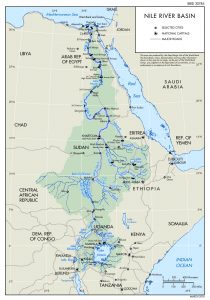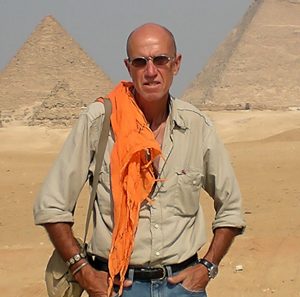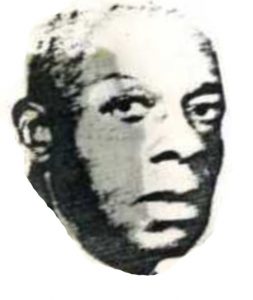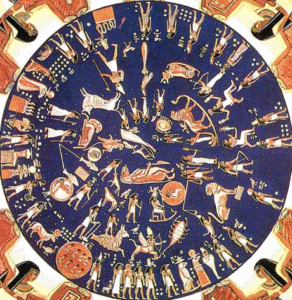Robert Bauval
Orion Correlation Theory (OCT)
The Orion Correlation Theory (OCT) is defined by Wikipedia as the idea “that there is a correlation between the location of the three largest pyramids of the Giza pyramid complex and Orion’s Belt of the constellation Orion, and that this correlation was intended as such by the original builders of the Giza pyramid complex.”
Robert Bauval is probably best known as the original promoter of the Orion Correlation Theory (OCT), which received widespread coverage when it was outlined in The Orion Mystery [1707] written by Bauval and Adrian Gilbert and in Keeper of Genesis [1050] written with Graham Hancock, published two years later. Bauval first published his theory in 1989 in Discussions in Egyptology(a).
Not unexpectedly, OCT generated considerable criticism as well as support, also noted on Wikipedia(g).
However, Andrew Collins has disputed the OCT and has instead offered evidence that the alignment of the three principal Giza pyramids matches more closely the ‘wing’ stars of the Cygnus constellation than the ‘belt’ of Orion!(b)
Gary A. David has expanded on the OCT of Bauval & Gilbert identifying important sites throughout Egypt that he believes constituted a more extensive reference with other heavenly bodies in what he calls the Egyptian Stellar Template(e).
David goes further and claims that he “stumbled across an Orion Correlation that the ancestral Hopi Indians constructed in Arizona from about 1050–1300 AD. In this case, every major star in the constellation corresponds to a specific masonry village site. The terrestrial replication of the celestial pattern is simply uncanny.”(f)
However, Freddy Silva has imaginatively proposed an additional OCT – in Scotland(c). He suggested that the Pyramids of Giza, and by extension, Orion’s Belt matched the layout of the three stone circles of Stenness, Brodgar and Bookan!
February 2015 saw an even more extreme idea published by Emilio Spedicato in a paper(h) with the radical proposal that the alignment of the three main Giza pyramids was not intended to be a reflection of the three stars in Orion’s belt according to the OCT, as proposed by Gilbert and Bauval, but instead were more closely matched to the arrangement of three volcanoes on Mars! He claims that these volcanoes were visible from Earth during Mars’ periodic close encounters with our planet between 7000 BC and 700 BC, during a 54-year cycle!
(a) Discussions in Egyptology, volume 13, 1989, pp. 7-18
(b) (99+) (PDF) Orion: The Eternal Rise of the Sky Hunter | Andrew Collins – Academia.edu
(c) Scotland’s Hidden Sacred Past – Graham Hancock Official Website
(d) http://www.migration-diffusion.info/article.php?year=2015&id=453
(e) https://www.academia.edu/8635347/The_Blazing_Star_of_the_Nile_Egyptian_Stellar_Template
(f) (99+) (PDF) Orion’s Global Legacy—A Celestial Plan | Gary David – Academia.edu
(h) https://www.q-mag.org/the-pyramids-of-giza-the-belt-of-orion-and-three-volcanoes-on-mars.html
Nile River *
 The River Nile was considered the longest river in the world, a title now disputed by the Amazon.(a) More important was the part it played in the development of pharoanic Egypt. Understandably, it also played a part in the mythology and religion of ancient Egypt.
The River Nile was considered the longest river in the world, a title now disputed by the Amazon.(a) More important was the part it played in the development of pharoanic Egypt. Understandably, it also played a part in the mythology and religion of ancient Egypt.
In 2019 a paper(d) by Larry Pahl, who looked again at the Orion Correlation Theory and concluded that Robert Bauval should not have confined his theory to Orion’s ‘belt’, but looked at the entire constellation and sought a more extensive reflection on the monuments of ancient Egypt. Prahl then proceeds to do exactly that.
Similarly, Jean-Pierre Lacroix claimed that other Egyptian structures may have been located to reflect the layout of other constellations in the sky. Specifically, he focuses on Aries and Thebes(e) .
Alessandro Berio went further with the claim(f) that the entire Nile was ‘designed’ to be a reflection of the constellations above!
Philip Coppens commenting on how the Incas viewed the valley of Cusco wrote “Modern research suggests that the Sacred Valley of the Vilcamayu and Urubamba rivers symbolised the Milky Way. Identifying rivers with constellations, specifically the Milky Way, is nothing new. Other examples are the Nile, as well as the Po in Italy and the Rhône in France.”(b)
Derek Cunningham claims to have discovered(c) that there is an association between the layout of the Stonehenge complex with the Milky Way!
(a) Nile – Wikipedia
(b) Viracocha’s voyage – Eye Of The Psychic
(c) https://atlantipedia.ie/samples/archive-3055/
(d) https://www.academia.edu/41868838/Expanding_the_Orion_Correlation_Theory_OCT_
Hall of Records
The Hall of Records (HoR) is a term used to describe an alleged repository of ancient wisdom, frequently claimed to be situated under the Sphinx at Giza. Today, the HoR is usually associated with the prognostications of Edgar Cayce who, in one of his trances, told us that there were three such repositories, near Bimini, the Yucatan and Giza.
Popular writers Robert Bauval and Graham Hancock were convinced that the HoR had been situated under the rear paws of the Sphinx in Keepers of Genesis [1050], published as Message of the Sphinx in the USA. Ian Lawton & Chris Ogilvie-Herald have noted in Giza the Truth [1690] how both Bauval and Hancock have modified their view of the HoR in a later video [p.400]. Cayce thought that the HoR would be found under the left paw of the Sphinx.
Lawton & Ogilvie-Herald also review the comments of other writers, both modern and ancient regarding the HoR. Their preliminary conclusion was “that it would appear that the weight of evidence supports the idea that secret records of mankind’s ancient past and knowledge do indeed exist in various locations in the world. However, the evidence linking them to Giza is far less substantial.” [p.242]
In 2000, Ralph Ellis announced his intention to lead an expedition to Mount Kailash in Nepal to find the Hall of Records!(a)
(a) Atlantis Rising magazine #23 p15 http://www.pdfarchive.info/index.php?pages/At *
David, Gary, A.
Gary A. David is an independent American researcher and author dealing with archaeological ruins and rock art of the American Southwest. His focus is on the Hopi tribe of northern Arizona and its archaeo-astronomy. Although he has not written directly about Atlantis, he has contributed a number of interesting papers relating to subjects peripheral to our study here. Most of these are available on the Academia.edu website(a).
David has also written about the Orion Correlation Theory (OCT) of Bauval & Gilbert, which claims that the alignment of the three stars in Orion’s ‘belt’ is reflected in the layout of the three principal pyramids at Giza.
David has expanded on the OCT of Bauval & Gilbert identifying important sites throughout Egypt that he believes constituted a more extensive reference with other heavenly bodies in what he calls the Egyptian Stellar Template(e).
He goes further and claims that he “stumbled across an Orion Correlation that the ancestral Hopi Indians constructed in Arizona from about 1050–1300 AD. In this case, every major star in the constellation corresponds to a specific masonry village site. The terrestrial replication of the celestial pattern is simply uncanny.” (b)
David has published an informative paper(c) on the Maltese Cross and its variants as found around the world. He pointed out its use in the Americas by the ancient Olmecs and has laid great emphasis on its place in the inherited culture of the Hopi people.
>David has also proposed that Votan was a diffusionist deity with counterparts known by other names such as Kukulkan, Quetzalcoatl or Viracocha in different pre-Columbian American civilisations. However, he goes further placing Votan’s origins in the Old World suggesting that he may have been Phoenician or Hebrew, citing Adrian Gilbert and Andrew Collins in support of this(f).<
Additionally, he has also highlighted the use of the swastika in a more benign way by the Hopi of northern Arizona along with its innocent use in other cultures including the Minoans, as well as in 20th century USA(d).
(a) https://colorado.academia.edu/GaryADavid
(b) (99+) (PDF) Orion’s Global Legacy—A Celestial Plan | Gary David – Academia.edu
(c) https://www.academia.edu/8661701/The_Maltese_Cross_Hopi_Indian_Version_of_a_Knights_Templar_Symbol
(d) https://www.academia.edu/8661508/The_Four_Arms_of_Destiny_Swastikas_in_the_Hopi_World_and_Beyond
(e) https://www.academia.edu/8635347/The_Blazing_Star_of_the_Nile_Egyptian_Stellar_Template
Bauval, Robert *
Robert Bauval (1948- ) was born in Egypt of Belgian and Maltese extraction. He is probably best known  as the original promoter of the Orion Correlation Theory (OCT), which claims that the layout of three principal Giza pyramids mirrors ‘Orion’s Belt’ in that constellation. This received widespread coverage when it was outlined in The Orion Mystery [1707] written by Bauval and Adrian Gilbert and in Keeper of Genesis [1050] written with Graham Hancock, published two years later. In fact, Bauval had first published his theory in 1989 in Discussions in Egyptology(a).
as the original promoter of the Orion Correlation Theory (OCT), which claims that the layout of three principal Giza pyramids mirrors ‘Orion’s Belt’ in that constellation. This received widespread coverage when it was outlined in The Orion Mystery [1707] written by Bauval and Adrian Gilbert and in Keeper of Genesis [1050] written with Graham Hancock, published two years later. In fact, Bauval had first published his theory in 1989 in Discussions in Egyptology(a).
Nevertheless, Andrew Collins, in a recent paper(h) has disputed Bauval’s OCT and has instead offered evidence that the alignment of the three principal Giza pyramids matches more closely the ‘wing’ stars of the Cygnus constellation than the ‘belt’ of Orion!
Greg Little in considering the Orion vs Cygnus debate concluded that “the truth is that Cygnus fits the three pyramids at Giza far better than Orion does. Does that mean that Cygnus is correct? No, not really. It means that there is a lot more investigation has to be done. It also means that we may never know. I’m sure that somewhere in the night sky there are three stars that can fit rather precisely onto Giza.” (I).
In 2008, Bauval published a paper(j) on the place of astrology in the ‘Sacred Sciences of the ancient Egyptians. Although this is not a popular view among Egyptologists, Bauval concluded that “it is my opinion that the ancient Egyptians practised an esoteric form of ‘religious astrology’ related to the conception and birth of their kings. It is also my opinion that this ‘religious astrology’ originated many millennia before in prehistoric times in the Eastern Sahara, as the astronomical alignments of the megaliths at Nabta Playa suggest. If this is true, then the stellar observations that originated in the Western Desert of Egypt some time between 8000 – 5000 BC events on earth lie at the root of ‘Astrology’.”
Bauval and Thomas G. Brophy co-authored two books, Black Genesis: The Prehistoric Origins of Ancient Egypt [1508B] and Imhotep the African [1509], in which they trace the origins of pharaonic Egypt back to a time before the Sahara became a desert and when dark-skinned people created the Nabta Playa megaliths. When the climate changed these people were forced to move eastward into the Nile Valley developing what we now call Ancient Egypt.
In 2019 a paper(k) by Larry Pahl, looked again at the Orion Correlation Theory and concluded that Bauval should not have confined his theory to Orion’s ‘belt’, but looked at the entire constellation and sought a more extensive reflection on the monuments of ancient Egypt. Prahl then proceeds to do exactly that.
Similarly, Jean-Pierre Lacroix claimed that other Egyptian structures may have been located to reflect the layout of other constellations in the sky. Specifically, he focuses on Aries and Thebes(l).
Alessandro Berio went further with the claim(m) that the entire Nile was ‘designed’ to be a reflection of the constellations above!
Another writer, Wayne Herschel, is claimed to have reinterpreted Bauval’s Orion theory in his book The Hidden Records [1706] and not only claims that the Giza pyramids reflect the layout of stars in Orion’s Belt, but that a similar arrangement of ‘pyramids’ in the Cydonia region of Mars is also to be found. Emilio Spedicato is another supporter of this Cydonia-Giza-Orion association(g)!
Herschel’s volume is a glossy collection of balderdash, which includes such delights as the Martians having a penal colony on Earth, as well as a promise of a sequel that will reveal “two further shocking secrets of the Sphinx.” Eventually, The Alpha Omega Taurus Star Gate was published with a new collection of balderdash. The odd idea of Earth as an alien penal colony has also been put forward by Dr Ellis Silver an American ecologist(f).
During one interview Bauval declared that “To be very honest, I am not a believer in Atlantis.”(b) However, he has no difficulty in adopting the idea of ancient astronaut visitors a la von Däniken, as revealed in Cosmic Womb [1708], written with Chandra Wickramasinghe and reviewed by Jason Colavito(c). This conversion to the idea of ancient astronauts was seen by Len Kasten as a natural progression. In an article published in Atlantis Rising (Issue 5), Kasten noted that Bauval “didn’t start out with the extraterrestrial hypothesis, but arrived at it after a painstaking study of the Pyramid Texts, and a corresponding highly scientific astronomical study of the monuments.” [Kasten, a UFO researcher, was a regular contributor to Atlantis Rising.]
Zahi Hawass, the former Egyptian Minister of Antiquities has repeatedly clashed with Bauval, particularly in connection with the proposed Orion correlation. In April 2015, Hancock was due to engage in a debate with Hawass on the subject of their conflicting views of ancient history. However, when Hawass saw that Hancock included an image of Robert Bauval in his presentation, he refused to continue with the arranged format(d)(e) and after a lot of shouting, from Hawass, he stormed out. This sort of ‘prima donna’ behaviour, although not very professsional, is consistent with Hawass’s well-known temperamental manner.
The antipathy between Bauval and Hawass reached a new level with the publication of Breaking the Mirror of Heaven [1913]+ written by Bauval and Ahmed Osman in 2012. The authors claim that “it is not merely the story of a man who dominated and controlled Egyptian antiquities for several decades as if they were his own but also the story of Egyptian archaeology itself and the way modern Egypt created such a man. These topics need to be properly reviewed, first to understand how, and why, Zahi Hawass became what he is and, second, to provide a new vision that is desperately needed to save Egyptian antiquities from decline and perhaps even total destruction.” David Rohl commented that “This is a book that needed to be written.”
In 2020, Massimo Barbetta published a review of Bauval’s OCT(n).
[1913]+ Available online: Breaking the Mirror of Heaven: The Conspiracy to Suppress the Voice of Ancient Egypt – PDFDrive.com (archive.org) (link broken) *
(a) Discussions in Egyptology, volume 13, 1989, pp. 7-18
(b) https://grahamhancock.com/interview-robert-bauval/
(d) https://www.grahamhancock.com/forum/HancockG15.php
(g) https://www.q-mag.org/the-pyramids-of-giza-the-belt-of-orion-and-three-volcanoes-on-mars.html
(h) (99+) (PDF) Orion: The Eternal Rise of the Sky Hunter | Andrew Collins – Academia.edu
(j) (99+) (PDF) ASTROLOGY IN ANCIENT EGYPT | Robert Bauval – Academia.edu
(k) https://www.academia.edu/41868838/Expanding_the_Orion_Correlation_Theory_OCT_
(l) http://www.ancientcartography.net/index1.html
(n) https://www.larazzodeltempo.it/2020/bauval-piramide/
Lawton, Ian *
 Ian Lawton (1959- ) is an English researcher focused on ancient history and spiritual philosophy. He is probably best known as the co-author with Chris Ogilvie-Herald of Giza: The Truth [1690], which offers a sober forensic review of all the many and widely varied theories relating to the ancient structures on the Giza Plateau. In it, Lawton was highly critical of Robert Bauval‘s Orion Correlation Theory (OCT) both in the book (chapter 9)(d) and in open correspondence between them.
Ian Lawton (1959- ) is an English researcher focused on ancient history and spiritual philosophy. He is probably best known as the co-author with Chris Ogilvie-Herald of Giza: The Truth [1690], which offers a sober forensic review of all the many and widely varied theories relating to the ancient structures on the Giza Plateau. In it, Lawton was highly critical of Robert Bauval‘s Orion Correlation Theory (OCT) both in the book (chapter 9)(d) and in open correspondence between them.
However, Lawton was at the receiving end of criticism from the late John Anthony West in 2000, when West published an article in Atlantis Rising magazine that ended with a scornful “The point is that the facile assurances given by Ogilvie-Herald/Lawton endorsing the orthodox view are illegitimate, their exclusion of contrary, genuinely informed opinion is typical of their selective bogus scholarship, and their long-winded acoustic levitation hypothesis is pure speculation and self-contradictory besides. We still don’t know how the pyramids were built/ Period. Full stop.”(e)
Two years later Ogilvie-Herald co-authored Tutankhamun [1898] with Andrew Collins.
Lawton has also been highly critical of the claims of the late Zechariah Sitchin(b) and his book Mesopotamia: The Truth [1751], he returns to the subject.
Lawton’s second book, Genesis Unveiled [1691], has been described as containing “remarkable new insights into the spirituality of the pre-flood human race”. Chapter 13 takes a somewhat generous view of Blavatsky and Theosophy(c).
He subsequently made changes(a) to the content and, in my opinion, opportunistically re-titled it as Atlantis: The Truth! In it Lawton has focused on prediluvian races, citing, with reservations, the work of Stephen Oppenheimer, Arysio dos Santos and Frank Joseph, which when added to Lawton’s research, he concludes that “it’s nevertheless interesting that all four of us have independently arrived at the same conclusion about the broad whereabouts of any forgotten race.” He argues that the location of such a race was in the general region of Sunda and Sahul Shelves.
(a) Atlantis: The Truth | Ian Lawton (archive.org) *
(b) Mesopotamia: The Truth | Ian Lawton (archive.org) *
(c) Atlantis: The Truth | Ian Lawton (archive.org) *
(d) Giza the Truth | Ian Lawton | Chris Ogilvie-Herald (archive.org) *
(e) Atlantis Rising magazine #23 http://www.pdfarchive.info/index.php?pages/At
Nabta Playa
Nabta Playa is a megalithic site situated 100 km west of Abu Simbel. It is the only known megalithic circle in Egypt, although in this instance ‘megalithic’ may be a misnomer as the components could have been erected by one person. A number of astronomical alignments have been identified at the site(a).
Although first rediscovered in 1974 by anthropology professor Fred Wendorf, it became known to a wider audience when astrophysicist Thomas G. Brophy published his book, The Origin Map[1510] in 2002. Wendorf was a contributor to a 2005 paper entitled Astronomy of Nabta Playa delivered to the African Astronomical History Symposium in Cape Town(g).>Wendorf also co-authored a paper with Romuald Schild in 2000 in which they offered a further detailed description of the site(i).<
The importance of Nabta Playa was further highlighted in a 2010 book by Robert Bauval & Thomas G. Brophy, Black Genesis[1508]. In it, they argue that the dark-skinned creators of Nabta Playa were the ancestors of the Egyptian culture, who migrated eastward as the Sahara dried up. The book has been reviewed favourably by Bruce Jeffries-Fox(b) and very critically by Jason Colavito in four parts(c-f). This was followed in 2012 by another book from Bauval & Brophy, Imhotep the African [1509], in which they explore further the development of ancient Egypt, particularly the part played by Imhotep.
Most sites(h) today (Sept. 2021) cite an estimated age of 7,000 years for Nabta Playa.
(a) https://humanoriginproject.com/nabta-playa-stone-circle/
(b) Origin of Egyptian Civilization (archive.org)
(c) https://www.jasoncolavito.com/blog/reviewing-black-genesis-pt-1
(d) https://www.jasoncolavito.com/blog/reviewing-black-genesis-pt-2
(e) https://www.jasoncolavito.com/blog/reviewing-black-genesis-pt-3
(f) https://www.jasoncolavito.com/blog/reviewing-black-genesis-final-part
(g) (PDF) Astronomy of Nabta Playa (archive.org) *
(h) Nabta Playa… – Physics and Nano
(i) Untitled (archive.org) *
Dendera Zodiac
The Dendera(h) Zodiac is a well-known bas-relief taken from the ceiling of the Hathor temple at Dendera in Egypt. The temple was constructed during the Graeco-Roman Period and removed by the French in 1821 and brought to Paris, where it can now be viewed in the Louvre.
Inevitably, there is controversy regarding the date that the zodiac was intended to represent. Not unexpectedly, the zodiac has also been drawn into the Atlantis debates with Albert Slosman claiming that the zodiac indicates a date of July 27th 9792 for the destruction of Atlantis[0550]! Slosman’s extreme ideas on the subject greatly influenced the thinking of others, including Patrick Geryl & Gino Ratinckx, Wolter Smit and Carlos Barcelo. Hossam Aboulfotouh has also offered an alternative interpretation of the Dendera Zodiac(a), with many more available on the internet.
Robert Bauval has written a series of seven short papers about Dendera and its Zodiac(b). A 2012 paper by Dr Rosalind Park & Bernard Eccles also offers a study of the Zodiac’s date(c).
>A March 2023 report revealed that another spectacular zodiac was discovered in the Temple of Esna which is about 60km south of Luxor, where restoration work has been going on since 2018(e).<
(a) https://www.geocities.ws/fotouh28/Decoding-Dendera-Zodiac.pdf
(b) https://web.archive.org/web/20041009215358/https://members.boardhost.com/Bauval/msg/1058.html
For the other six papers substitute 1058 with 1062, 1065, 1067, 1074, 1076, and 1080.
(d) https://calteches.library.caltech.edu/4096/1/Egyptian.pdf *
(e) Complete Depiction of The Zodiac Found in Ancient Egyptian Temple : ScienceAlert *
Cygnus Constellation, The
The Cygnus Constellation was the location of a supernova that inspired the story of Phaeton, as related to Solon by the priests at Sais, according to Michael A. Cahill in his two-volume Paradise Rediscovered [818/9].
 Andrew Collins has also written[075] on the place of the constellation Cygnus in prehistoric consciousness. Arising from this study, it appears that the position of the Cygnus stars correlates more accurately with the Giza pyramids than those of Orion, which was proposed some years ago by Robert Bauval. Collins continues with the Cygnus-Giza connection in a subsequent offering, Beneath the Pyramids[0631]. Derek Cunningham has echoed(a) some of Collins’ work suggesting that there existed in ancient times a World Map based on the Cygnus constellation!
Andrew Collins has also written[075] on the place of the constellation Cygnus in prehistoric consciousness. Arising from this study, it appears that the position of the Cygnus stars correlates more accurately with the Giza pyramids than those of Orion, which was proposed some years ago by Robert Bauval. Collins continues with the Cygnus-Giza connection in a subsequent offering, Beneath the Pyramids[0631]. Derek Cunningham has echoed(a) some of Collins’ work suggesting that there existed in ancient times a World Map based on the Cygnus constellation!
Collins has also suggested that a suspected Black Hole in Cygnus Constellation is thought to be the source of cosmic rays that changed evolution and kick-started religion(d)!
Anthony Murphy and Richard Moore have also written(b) about the Cygnus Constellation and a possible link with Ireland’s Newgrange[1441].>This idea was echoed in a recent episode of Ancient Aliens (S18E17)(f).<Paul Dunbavin also touched on the possible connection between swans in Irish mythology and astronomical events(e).
Freddy Silva has endeavoured to link Cygnus with the Osirion in Abydos in a 2019 article(c) in which he dated the structure to 10,500 BC.
(a) https://www.midnightsciencejournal.com/?s=Cygnus
(b) Mythical Ireland | Astronomy | The Cygnus Enigma (archive.org) *
(c) https://invisibletemple.com/extra/osirion-link-to-cygnus-10,500BC.html
(e) https://www.third-millennium.co.uk/irishgodkings
(f) Review of Ancient Aliens S18E17: “The Shining Ones” – JASON COLAVITO *
James, George G.M. *
George G. M. James (1893-1956) a professor of ancient Greek, was born in British Guiana and lectured at a number of North American universities. He gained widespread notoriety with his 1954 book,  Stolen Legacy(a), in which he claimed that “the term Greek philosophy is in fact wrong because there is no such philosophy. The Greeks did not have the natural ability necessary for the development of philosophy. The Greek philosophy was not invented by Greeks but by the Blacks of Northern Africa, the Egyptians”. His ‘chip-on-the-shoulder’ Afrocentrism pervades his book, often sinking into downright racism. A sceptic’s view of James’ claims gives some balance to the debate(b).
Stolen Legacy(a), in which he claimed that “the term Greek philosophy is in fact wrong because there is no such philosophy. The Greeks did not have the natural ability necessary for the development of philosophy. The Greek philosophy was not invented by Greeks but by the Blacks of Northern Africa, the Egyptians”. His ‘chip-on-the-shoulder’ Afrocentrism pervades his book, often sinking into downright racism. A sceptic’s view of James’ claims gives some balance to the debate(b).
Our interest in James stems from his claim[858.109] that both Republic and Timaeus were stolen by Plato and quotes the 3rd century AD biographer, Diogenes Laërtius (8.85), in support of his contention. Although he touches on the authorship of Timaeus he does not refer to the Atlantis passages.
James’ unorthodoxy is not confined to a criticism of the origins of Greek philosophy, but elsewhere claims that the pyramids were built around 10,000 BC, predating the claims of Graham Hancock and Robert Bauval by decades.
(a) (99+) Stolen Legacy | karahbura nebjari – Academia.edu *


